Page 2 of 468
1-800-CHEV-USA
(For vehicles purchased in Canada,
call
1-800-268-6800)
that provides in an emergency:
Free lockout assistance
Free dead-battery assistance
Free out-of-fuel assistance
Free flat-tire change
Emergency towing
Courtesy
Transportation
Every
2001
Silverado under
warranty is backed
with the following
services:®
1-800-CHEV-USA
(For vehicles purchased in Canada,
call
1-800-268-6800)
Page 5 of 468
iii
Section
3
Comfort Controls and Audio Systems
Section
4
Your Driving and the Road
Section
5
Table of Contents (cont'd)
Your Driving, the Road and Your Vehicle
Defensive Driving
Drunken Driving
Control of a Vehicle
Braking
SteeringDriving Tips for Various Road Conditions
Off-Road Driving
Recreational Vehicle Towing
Loading Your Vehicle
Towing a Trailer Heating and Air Conditioning
Setting the Radio ClockRadio/Cassette Player/CD Player
Radio Theft-Deterrent Feature (If Equipped)
Hazard Warning Flashers
Jump Starting
Towing Your VehicleEngine Overheating
Changing a Flat Tire
If You're Stuck
Problems on the Road
Page 101 of 468
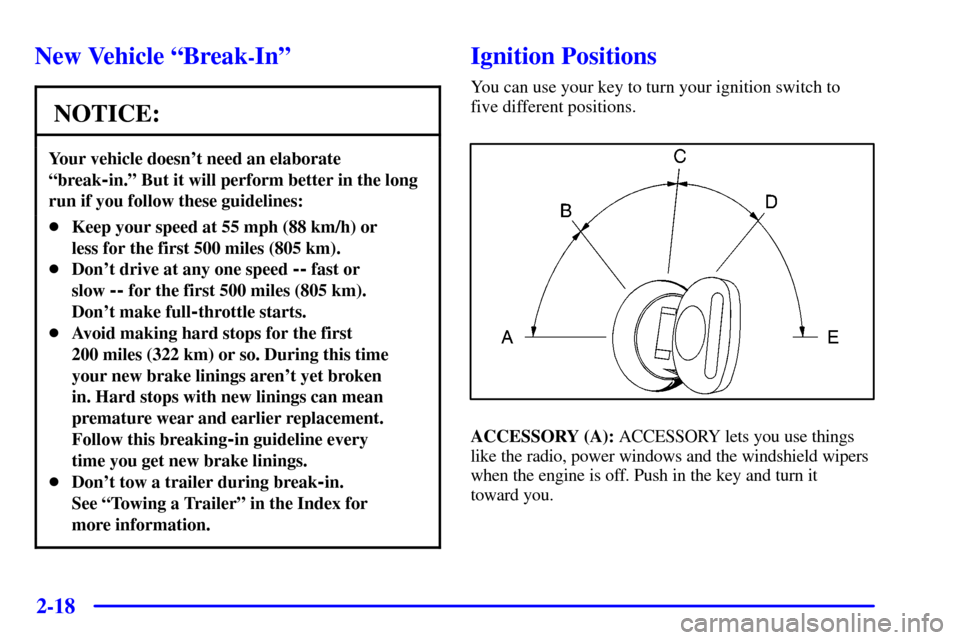
2-18
New Vehicle ªBreak-Inº
NOTICE:
Your vehicle doesn't need an elaborate
ªbreak
-in.º But it will perform better in the long
run if you follow these guidelines:
�Keep your speed at 55 mph (88 km/h) or
less for the first 500 miles (805 km).
�Don't drive at any one speed
-- fast or
slow
-- for the first 500 miles (805 km).
Don't make full
-throttle starts.
�Avoid making hard stops for the first
200 miles (322 km) or so. During this time
your new brake linings aren't yet broken
in. Hard stops with new linings can mean
premature wear and earlier replacement.
Follow this breaking
-in guideline every
time you get new brake linings.
�Don't tow a trailer during break
-in.
See ªTowing a Trailerº in the Index for
more information.
Ignition Positions
You can use your key to turn your ignition switch to
five different positions.
ACCESSORY (A): ACCESSORY lets you use things
like the radio, power windows and the windshield wipers
when the engine is off. Push in the key and turn it
toward you.
Page 108 of 468
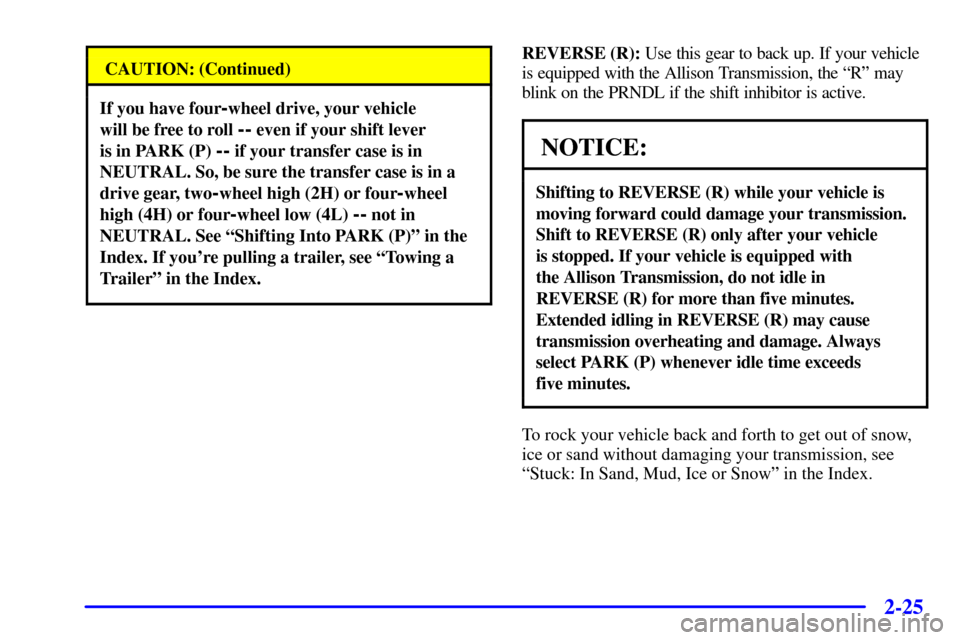
2-25
CAUTION: (Continued)
If you have four-wheel drive, your vehicle
will be free to roll
-- even if your shift lever
is in PARK (P)
-- if your transfer case is in
NEUTRAL. So, be sure the transfer case is in a
drive gear, two
-wheel high (2H) or four-wheel
high (4H) or four
-wheel low (4L) -- not in
NEUTRAL. See ªShifting Into PARK (P)º in the
Index. If you're pulling a trailer, see ªTowing a
Trailerº in the Index.
REVERSE (R): Use this gear to back up. If your vehicle
is equipped with the Allison Transmission, the ªRº may
blink on the PRNDL if the shift inhibitor is active.
NOTICE:
Shifting to REVERSE (R) while your vehicle is
moving forward could damage your transmission.
Shift to REVERSE (R) only after your vehicle
is stopped. If your vehicle is equipped with
the Allison Transmission, do not idle in
REVERSE (R) for more than five minutes.
Extended idling in REVERSE (R) may cause
transmission overheating and damage. Always
select PARK (P) whenever idle time exceeds
five minutes.
To rock your vehicle back and forth to get out of snow,
ice or sand without damaging your transmission, see
ªStuck: In Sand, Mud, Ice or Snowº in the Index.
Page 109 of 468
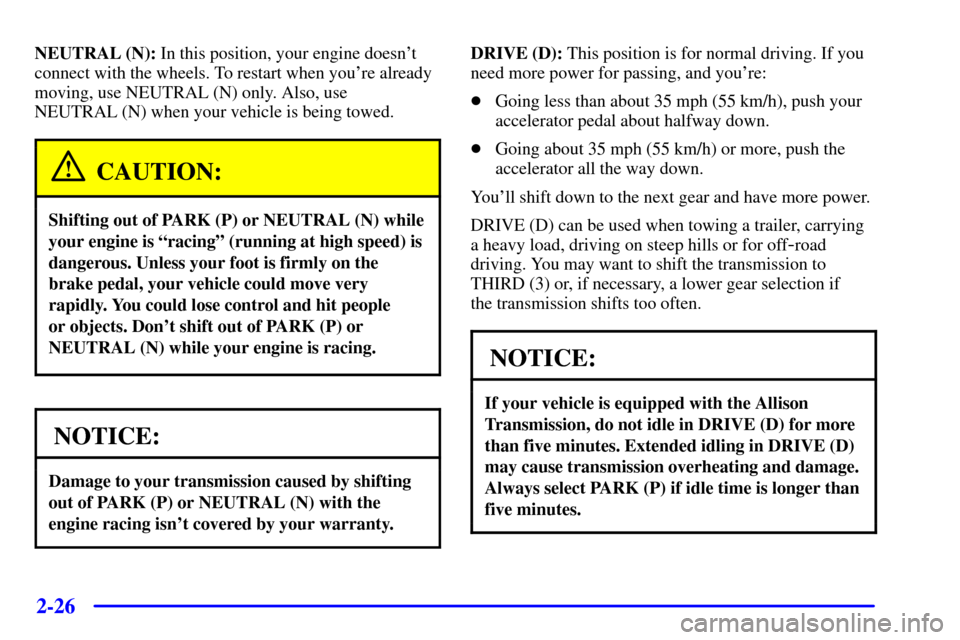
2-26
NEUTRAL (N): In this position, your engine doesn't
connect with the wheels. To restart when you're already
moving, use NEUTRAL (N) only. Also, use
NEUTRAL (N) when your vehicle is being towed.
CAUTION:
Shifting out of PARK (P) or NEUTRAL (N) while
your engine is ªracingº (running at high speed) is
dangerous. Unless your foot is firmly on the
brake pedal, your vehicle could move very
rapidly. You could lose control and hit people
or objects. Don't shift out of PARK (P) or
NEUTRAL (N) while your engine is racing.
NOTICE:
Damage to your transmission caused by shifting
out of PARK (P) or NEUTRAL (N) with the
engine racing isn't covered by your warranty.
DRIVE (D): This position is for normal driving. If you
need more power for passing, and you're:
�Going less than about 35 mph (55 km/h), push your
accelerator pedal about halfway down.
�Going about 35 mph (55 km/h) or more, push the
accelerator all the way down.
You'll shift down to the next gear and have more power.
DRIVE (D) can be used when towing a trailer, carrying
a heavy load, driving on steep hills or for off
-road
driving. You may want to shift the transmission to
THIRD (3) or, if necessary, a lower gear selection if
the transmission shifts too often.
NOTICE:
If your vehicle is equipped with the Allison
Transmission, do not idle in DRIVE (D) for more
than five minutes. Extended idling in DRIVE (D)
may cause transmission overheating and damage.
Always select PARK (P) if idle time is longer than
five minutes.
Page 111 of 468
2-28
Tow/Haul Mode Selector Switch
(Automatic Transmission)
Your vehicle is equipped with a tow/haul mode. The
selector switch is located on the end of the column shift
lever. You can use this feature to assist when towing or
hauling a heavy load. See ªTow/Haul Modeº in the
Index for more information.
Manual Transmission Operation
5-Speed (VORTEC 6000 V8 Engine)
Here's how to operate
your transmission.
FIRST (1) is intended only for heavy loads or trailer
towing and is not recommended for normal driving.
During the first 500 miles (805 km) of vehicle use, start
your vehicle moving in FIRST (1). This allows clutch
components to break
-in properly.
Page 114 of 468
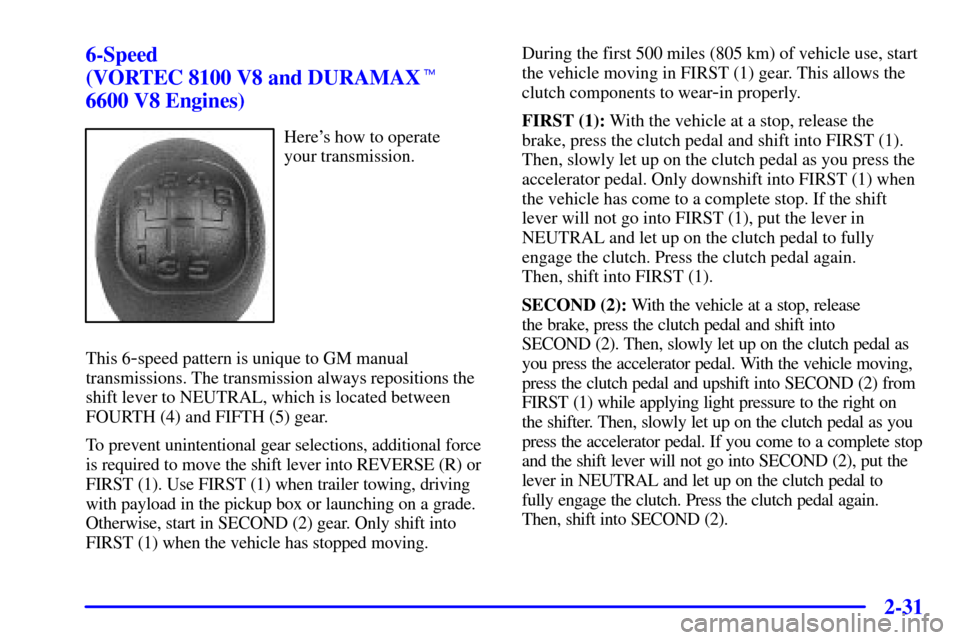
2-31
6-Speed
(VORTEC 8100 V8 and DURAMAX�
6600 V8 Engines)
Here's how to operate
your transmission.
This 6
-speed pattern is unique to GM manual
transmissions. The transmission always repositions the
shift lever to NEUTRAL, which is located between
FOURTH (4) and FIFTH (5) gear.
To prevent unintentional gear selections, additional force
is required to move the shift lever into REVERSE (R) or
FIRST (1). Use FIRST (1) when trailer towing, driving
with payload in the pickup box or launching on a grade.
Otherwise, start in SECOND (2) gear. Only shift into
FIRST (1) when the vehicle has stopped moving.During the first 500 miles (805 km) of vehicle use, start
the vehicle moving in FIRST (1) gear. This allows the
clutch components to wear
-in properly.
FIRST (1): With the vehicle at a stop, release the
brake, press the clutch pedal and shift into FIRST (1).
Then, slowly let up on the clutch pedal as you press the
accelerator pedal. Only downshift into FIRST (1) when
the vehicle has come to a complete stop. If the shift
lever will not go into FIRST (1), put the lever in
NEUTRAL and let up on the clutch pedal to fully
engage the clutch. Press the clutch pedal again.
Then, shift into FIRST (1).
SECOND (2): With the vehicle at a stop, release
the brake, press the clutch pedal and shift into
SECOND (2). Then, slowly let up on the clutch pedal as
you press the accelerator pedal. With the vehicle moving,
press the clutch pedal and upshift into SECOND (2) from
FIRST (1) while applying light pressure to the right on
the shifter. Then, slowly let up on the clutch pedal as you
press the accelerator pedal. If you come to a complete stop
and the shift lever will not go into SECOND (2), put the
lever in NEUTRAL and let up on the clutch pedal to
fully engage the clutch. Press the clutch pedal again.
Then, shift into SECOND (2).
Page 118 of 468
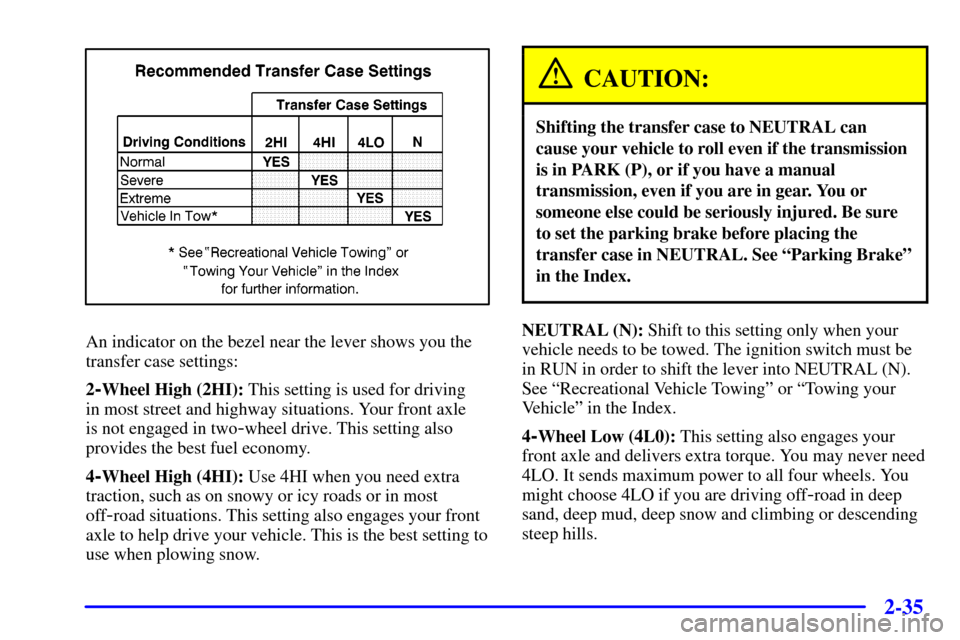
2-35
An indicator on the bezel near the lever shows you the
transfer case settings:
2
-Wheel High (2HI): This setting is used for driving
in most street and highway situations. Your front axle
is not engaged in two
-wheel drive. This setting also
provides the best fuel economy.
4
-Wheel High (4HI): Use 4HI when you need extra
traction, such as on snowy or icy roads or in most
off
-road situations. This setting also engages your front
axle to help drive your vehicle. This is the best setting to
use when plowing snow.
CAUTION:
Shifting the transfer case to NEUTRAL can
cause your vehicle to roll even if the transmission
is in PARK (P), or if you have a manual
transmission, even if you are in gear. You or
someone else could be seriously injured. Be sure
to set the parking brake before placing the
transfer case in NEUTRAL. See ªParking Brakeº
in the Index.
NEUTRAL (N): Shift to this setting only when your
vehicle needs to be towed. The ignition switch must be
in RUN in order to shift the lever into NEUTRAL (N).
See ªRecreational Vehicle Towingº or ªTowing your
Vehicleº in the Index.
4
-Wheel Low (4L0): This setting also engages your
front axle and delivers extra torque. You may never need
4LO. It sends maximum power to all four wheels. You
might choose 4LO if you are driving off
-road in deep
sand, deep mud, deep snow and climbing or descending
steep hills.